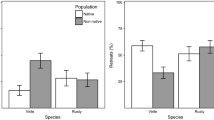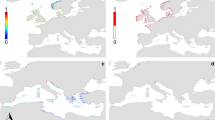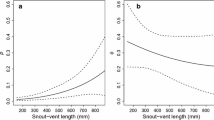Abstract
The native fauna of isolated island systems is generally unique with acute conservation issues. For spiders in Hawaii, the first impediment to effective conservation is lack of taxonomic knowledge. The primary conservation concerns are related to the highly localized areas of endemicity of many species, with associated small population sizes. Species on insular systems tend to occur naturally in small populations, and small population size itself may not be a cause for conservation concern. However, for spiders and other arthropods, which tend to have shorter generation times compared to vertebrates, population fluctuations will tend to be more frequent, rendering them more vulnerable to extinction through demographic accidents at small population size. The knowledge we have to date suggests that habitat disturbance and alien species invasion are probably the major factors affecting native spiders in the islands. For a given natural community, the ability of species to accommodate habitat perturbation may be related more to the novelty of the perturbation than to its apparent severity. Although native spiders appear to tolerate disruption of the species composition of the native vegetation, evidence suggests that they are severely impacted by alien arthropod predators, in particular social hymenoptera, a group not represented among native Hawaiian arthropods.
Similar content being viewed by others
References
Balmford, A. (1996) Extinction filters and current resilience: the significance of past selection pressures for conservation biology. Trends in Ecol. Evol. 11, 193–6.
Case, T.J. (1991) Invasion resistance, species build-up and community collapse in metapopulation models with interspecies competition. Biol. J. Linn. Soc. 42, 239–66.
Cole, F.R., Medeiros, A.C., Loope, L.L. and Zuehlke, W.W. (1992) Effects of the Argentine ant on arthropod fauna of Hawaiian high-elevation shrubland. Ecology 73, 1313–22.
Crawley, M.J. (1987) What makes a community invasible? In Colonization, succession and stability (M.J. Crawley, P.J. Edwards and A.J. Gray, eds), pp. 429–54. London: Blackwell Scientific.
Cuddihy, L.W. and Stone, C.P. (1990) Alteration of native Hawaiian vegetation: Effects of humans, their activities and introductions. Univ. of Hawaii Coop. Natl. Parks Stud. Unit, Honolulu, Hawaii.
De Pietri, D.E. (1992) Alien shrubs in a national park: Can they help in the recovery of natural degraded forest? Biol. Conserv. 62, 127–30.
Dunlop, B.N. (1989) Endangered and threatened wildlife and plants; animal notice of review. Federal Register 54, 554–79.
Eldredge, L.G. and Miller, S.E. (1994) How many species are there in Hawaii? Bishop Mus. Occ. Pap. 41, 3–18.
Fox, M.D. and Fox, B.J. (1986) The susceptibility of natural communities to invasion. In Ecology of biological invasions: An Australian perspective (R.H. Groves and J.J. Burdon, eds), pp. 57–66. Canberra: Australian Academy of Sciences.
Frankham, R. (1995) Conservation genetics. Ann. Rev. Genetics 29, 305–27.
Gambino, P. (1992) Yellowjacket (Vespula pensylvanica) predation at Hawaii Volcanoes and Haleakala National Parks: Identity of prey items. Proc. Haw. Ent. Soc. 31, 157–64.
Gambino, P., Medeiros, A.C. and Loope, L.L. (1990) Invasion and colonization of upper elevations on east Maui (Hawaii) by Vespula pensylvanica (Hymenoptera: Vespidae). Annals Ent. Soc. America 83, 1088–95.
Gertsch, W.J. (1973) The cavernicolous fauna of Hawaiian lava tubes 3. Araneae (Spiders). Pacif. Insects 15, 163–80.
Gillespie, R.G. (1991a) Hawaiian spiders of the genus Tetragnatha: I. Spiny-leg Clade. J. Arachnol. 19, 174–209.
Gillespie, R.G. (1991b) Predation through impalement of prey: The foraging behavior of Doryonychus raptor (Araneae, Tetragnathidae). Psyche, Camb. 98, 337–50.
Gillespie, R.G. (1992a) Hawaiian spiders of the genus Tetragnatha II. Species from natural areas of windward East Maui. J. Arachnol. 20, 1–17.
Gillespie, R.G. (1992b) Impaled prey. Nature, Lond. 355, 211–13.
Gillespie, R.G. (1994) Hawaiian spiders of the genus Tetragnatha: III. T. acuta Clade. J. Arachnol. 22, 161–8.
Gillespie, R.G. (1997) Range contraction and extinction vulnerability: What is natural? Mem. Mus. Vict. 56, 401–8.
Gillespie, R.G. and Reimer, N. (1993) The effect of alien predatory ants (Hymenoptera, Formicidae) on Hawaiian endemic spiders (Araneae, Tetragnathidae). Pacif. Sci. 47, 21–33.
Gillespie, R.G., Croom, H.B. and Palumbi, S.R. (1994) Multiple origins of a spider radiation in Hawaii. Proc. Natl. Acad. Sci. 91, 2290–4.
Gillespie R.G., Croom, H.B. and Hasty, G.L. (1997) Phylogenetic relationships and adaptive shifts among major clades of Tetragnatha spiders (Araneae: Tetragnathidae) in Hawaii. Pac. Sci. 51, 380–94.
Gillespie, R.G., Rivera, M.A. and Garb, J.E. (1998) Sun, surf and spiders: taxonomy and phylogeography of Hawaiian Araneae. In Proc. 17th European Colloquium of Arachnology, Edinburgh 1997. (P.A. Selden, ed.), pp. 41–51. Burnham Beeches, England: British Arachnological Society.
Hafernik, J.E. (1992) Threats to invertebrate biodiversity: Implications for conservation strategies. In Conservation Biology: The Theory and Practice of Nature Conservation, Preservation and Management (P.L. Fiedler and S.K. Jain, eds), pp. 171–95. New York: Chapman and Hall.
Haila, Y. and Hanski, I.K. (1993) Breeding birds on small British islands and extinction risks. Am. Nat. 142, 1025–9
Harris, R.J. (1991) Diet of the wasps Vespula vulgaris and V. germanica in honeydew beech forest of the South island, New Zealand. New Zealand J. Zool. 18, 159–69.
Howarth, F.G. (1987) Evolutionary ecology of aeolian and subterranean habitats in Hawaii. Trends in Ecol. Evol. 2, 220–3.
Howarth, F.G. (1985) Impacts of alien land arthropods and mollusks on native plants and animals in Hawaii. In Hawaii's Terrestrial Ecosystems: Preservation and Management (C.P. Stone and J.M. Scott, eds), pp. 149–79. Honolulu: University of Hawaii Press.
Howarth, F.G. and Ramsay, G.W. (1991) The conservation of island insects and their habitats. In The Conservation of Insects and Their Habitats (N.M. Collins and J.A. Thomas, eds), pp 71–107. Academic Press, New York.
Jourdan, H. (1997) Threats on Pacific Islands: The spread of the tramp ant Wasmannia auropunctata (Hymenoptera: Formicidae). Pacific Conservation Biology 3, 61–4.
Lawton, J.H. (1993) Range, population abundance and conservation. Trends in Ecol. Evol. 8, 409–13.
Liebherr, J.K. and Polhemus, D.A. (1997) R.C.L. Perkins: 100 years of Hawaiian entomology. Pac. Sci., 51, 343–55.
Lodge, D.M. (1993) Biological invasions: Lessons for ecology. Trends in Ecol. Evol. 8, 133–7.
Loope, L.L. and Mueller-Dombois, D. (1989) Characteristics of invaded islands, with special reference to Hawaii. In Biological Invasions: A Global Perspective (J.A. Drake et al., eds), pp. 257–80. England: John Wiley and Sons.
Loope, L.L., Hamann, O. and C.P Stone (1988) Comparative conservation biology of oceanic archipelagos. Bioscience 38, 271–82.
Lubin, Y.D. (1984) Changes in the native fauna of the Galapagos Islands following invasion by the little red fire ant Wasmannia auropunctata. Biol J. Linn Soc. 21, 229–42.
Medeiros, A.C., Loope, L.L. and Cole, F.R. (1986a) Distribution of ants and their effects on endemic biota of Haleakala and Hawaii Volcanoes National Parks: a preliminary assessment. In Proc. 6th Conf. Nat. Sci. Hawaii, pp. 39–52.
Medeiros, A.C., Loope, L.L. and Holt, R.A. (1986b) Status of native flowering plant species on the south slope of Haleakala, East Maui. Hawaii. Coop. Natl. Park Resources Study Unit, Hawaii, Techn. Rep. 59, 1–230.
Moguel, P. and Toledo, V.M. (1999) Biodiversity conservation in traditional coffee systems of Mexico. Conserv. Biol. 13, 11–21.
Moran, N.A. (1988) The evolution of host-plant alternation in aphids: evidence for specialization as a dead end. Am. Nat. 132, 681–706.
Nafus, D.M. (1993) Extinction, biological control, and conservation on islands. In Perspectives on Insect Conservation. (K.J. Gaston, T.R. New, and M.J. Samways, eds), pp. 139–54. Intercept, Andover.
Nentwig, W. (1983) The prey of web-building spiders compared to feeding experiments (Araneae: Araneidae, Linyphiidae, Pholcidae, Agelenidae). Oecologia 56, 131–9.
Olson, S.L. (1989) Extinction on islands: man as a catastrophe. In Conservation for the Twenty-first Century (D. Wesern and M.C. Pearl, eds) pp. 50–3. Oxford: Oxford University Press.
Olson, S.L. and James, H.F. (1982) Fossil birds from the Hawaiian Islands: evidence for wholsale extinction by man before western contact. Science 217, 633–5.
Otte, D. (1994) The crickets of Hawaii: origin, systematics and evolution. The Orthopterists’ Society: Academy of Natural Sciences of Philadelphia, PA.
Perkins, R.C.L. (1913) Introduction (to Fauna Hawaiiensis). Vol. 1. In Fauna Hawaiiensis. (D. Sharp, ed.). pp. xv–ccxxviii. Cambridge: Cambridge University Press.
Pimm, S.L. (1991) The balance of nature? Ecological issues in the conservation of species and communities, 434 pp. University of Chicago Press, Chicago.
Pimm, S.L., Jones, H.L. and Diamond, J. (1988) On the risk of extinction. Am. Nat. 132: 757–85.
Ricklefs, R.E. (1990) Ecology, 3rd edn. Regulation of community structure, pp. 748–75. New York: W.H. Freeman.
Riechert, S.E. and Gillespie, R.G. (1986) Habitat choice and utilization in the web spinners. In Spiders, Webs, Behavior, and Evolution (W.B. Shear, ed.), pp. 23–48. Stanford: Stanford University Press.
Roderick, G.K. and Gillespie, R.G. (1998) Speciation and phylogeography of Hawaiian terrestrial arthropods. Mol. Ecol. 7, 519–31.
Safford, J. and Jones, C.G. (1998) Strategies for land-bird conservation on Mauritius. Conserv. Biol. 12, 169–76.
Savidge, J.A. (1987) Extinction of an island forest avifauna by an introduced snake. Ecology 68, 660–8.
Simberloff, D. (1995) Why do introduced species appear to devastate islands more than mainland areas? Pac. Sci. 49, 87–97.
Simon, E. (1900) Arachnida: Fauna Hawaiiensis 2, 443–519, pls. 15-19.
Simon, E. (1904) Arachnida (supplement): Fauna Hawaiiensis 3, 339–44.
Smith, C.W. (1985) Impact of alien plants on Hawaii's native biota. In Hawaii's Terrestrial Ecosystems: Preservation and Management. (C.P. Stone and J.M. Scott, eds), pp. 180–250. Honolulu: University of Hawaii Press.
Stacey, P.B., Johnson, V.A. and Taper, M.L. (1997) Migration within metapopulations: The impact upon local population dymnamics. In Metapopulation Biology: Ecology, Genetics, and Evolution (I.A. Hanski and M.E. Gilpin, eds), pp. 267–91. Academic Press, New York.
Steadman, D.W. (1995) Prehistoric extinctions of Pacific Island birds; biodiversity meets zooarchaeology. Science 267, 1123–31.
Suman, T.W. (1970) Spiders of the Family Thomisidae in Hawaii. Pacif. Insects 12, 773–864.
Templeton, A.R. and Read, B. (1984) Factors eliminating inbreeding depression in a captive herd of Speke's gazelle (Gazella spekei) Zoo. Biol. 3, 177–99.
Tracy, C.R. and George, T.L. (1992) On the determinants of extinction. Am. Nat. 139, 101–22.
Wagner, W.L. and Funk, V.A. (1995) Hawaiian biogeography evolution on a hot spot archipelago. Washington, DC, Smithsonian Institution Press.
Wagner, W.L., Herbst, D.R. and Sohmer, S.H. (1990) Manual of the Flowering Plants of Hawaii. Bishop Museum and Univ. of Hawaii Presses, Honolulu.
Williamson, M. 1981. Island Populations. Oxford: Oxford University Press.
Zimmerman, E.C. (1948) Insects of Hawaii, vol. I. Introduction. University of Hawaii Press, Honolulu.
Author information
Authors and Affiliations
Rights and permissions
About this article
Cite this article
Gillespie, R. Naiveté and Novel Perturbations: Conservation of Native Spiders on an Oceanic Island System. Journal of Insect Conservation 3, 263–272 (1999). https://doi.org/10.1023/A:1009654820519
Issue Date:
DOI: https://doi.org/10.1023/A:1009654820519




